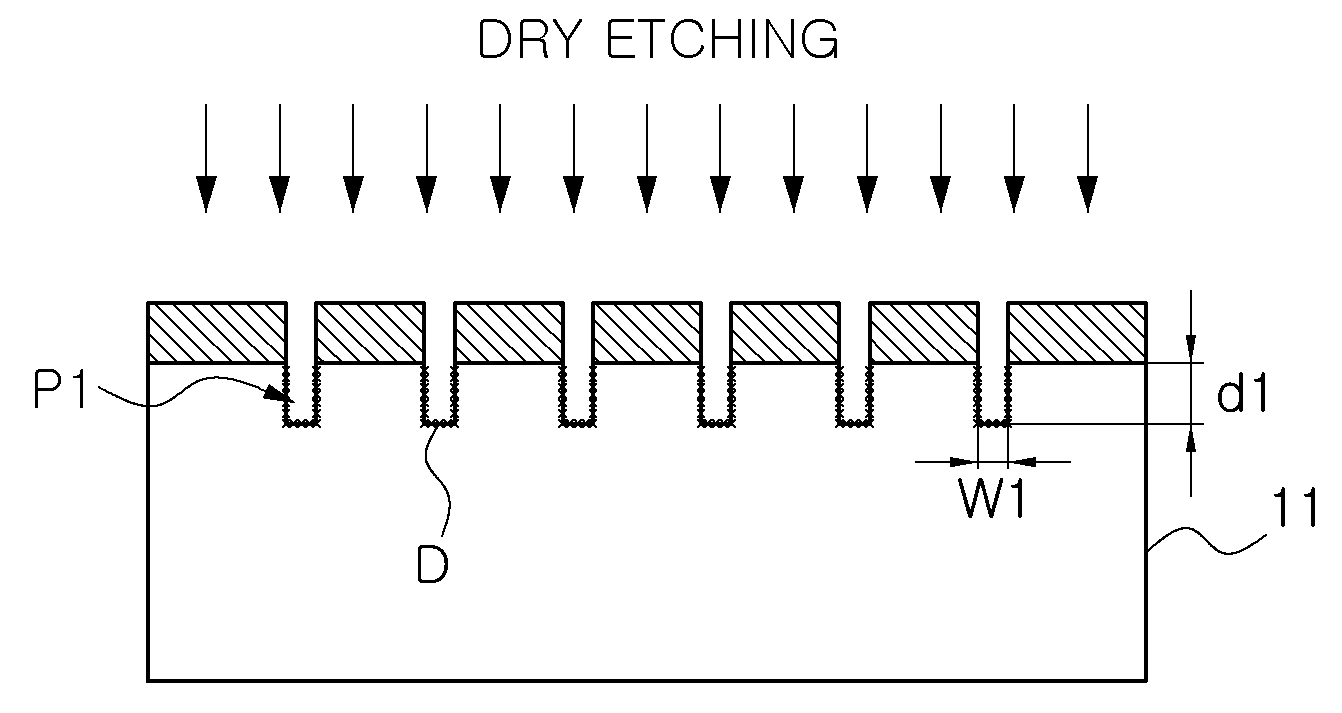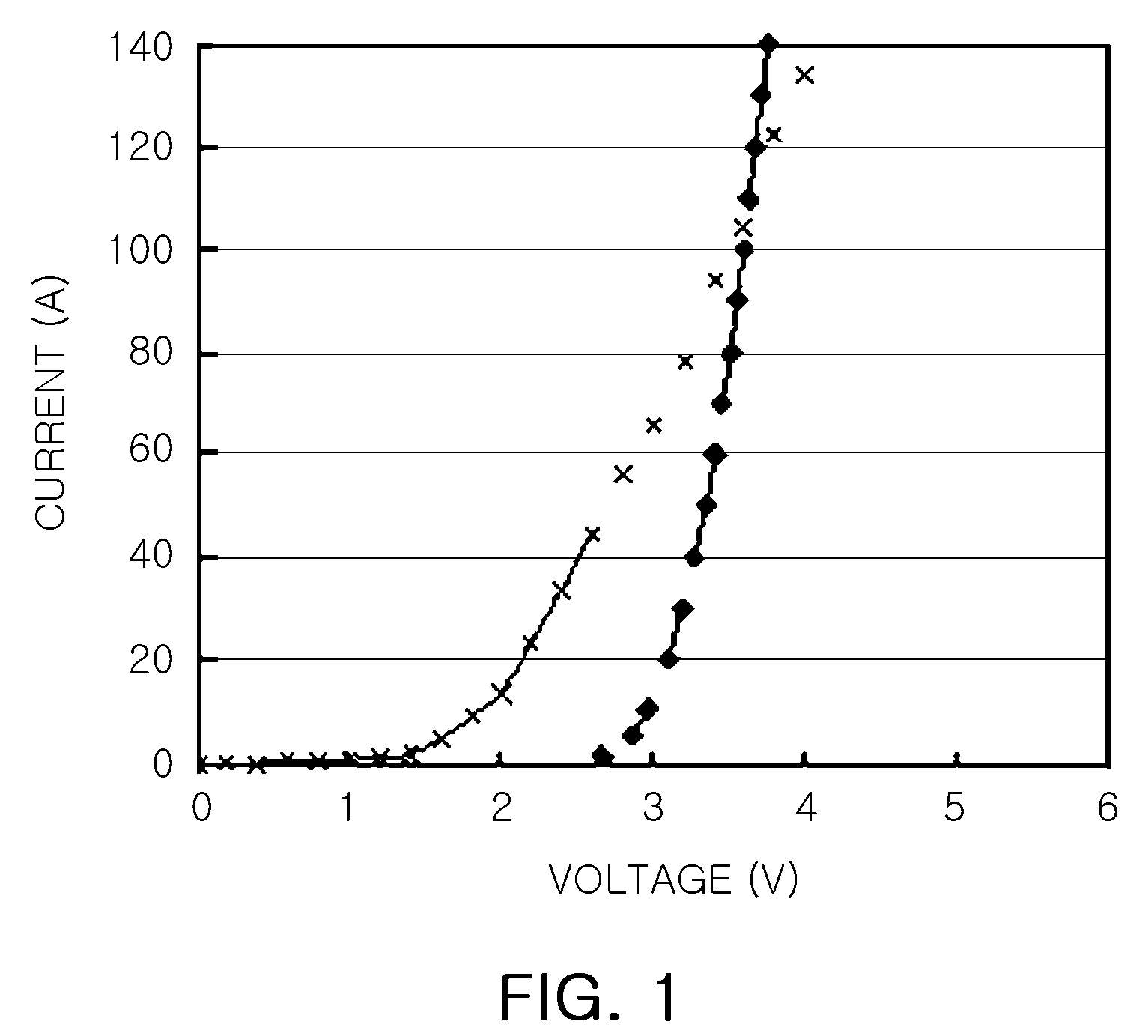Method of forming fine patterns and manufacturing semiconductor light emitting device using the same
a technology of semiconductor light emitting devices and fine patterns, which is applied in the direction of semiconductor devices, decorative arts, electrical equipment, etc., can solve the problems of limited light extraction efficiency, easy deterioration of semiconductor surface properties, and limitations of the etching process used in this patterning process to form fine patterns on a semiconductor surface. , to achieve the effect of minimizing the damage area
- Summary
- Abstract
- Description
- Claims
- Application Information
AI Technical Summary
Benefits of technology
Problems solved by technology
Method used
Image
Examples
embodiment 1a
[0073]According to the current embodiment, a mask having line patterns formed in a orientation and arranged in a orientation is formed on a c-plane GaN semiconductor crystal. A period of the line patterns is set to about 0.6 μm. Thereafter, dry etching is performed up to a depth of about 0.1 μm, and then the mask is removed (see FIG. 3A).
[0074]Thereafter, wet etching using a 4M KOH aqueous solution is performed at about 100° C. for about 10 minutes, then an observation is made using a scanning electron microscope, and then the wet etching is further performed for about 20 minutes (total 30 minutes).
[0075]As a result of the wet etching performed for about ten minutes, an initial sidewall which is somewhat inclined becomes a vertical sidewall as shown in FIG. 3B. Since the sidewall becomes a {1-100} plane, which is a relatively stable crystal plane of GaN, i.e., an m-plane, the sidewall is no longer etched during the additional wet etching for about 20 minutes. Of course, a bottom s...
embodiment 1b
[0077]According to this embodiment, similarly to the embodiment 1A, a mask having a plurality of line patterns (period: about 0.6 μm) is formed on a c-plane GaN semiconductor crystal. The difference there is a formation orientation and an arrangement orientation thereof. That is, according to the current embodiment, a plurality of line patterns are formed in a orientation and arranged in a orientation. Thereafter, dry etching is performed up to a depth of about 0.1 μm, and then the mask is removed (see FIG. 4A).
[0078]Thereafter, wet etching using a 4M KOH aqueous solution is performed at a temperature of about 100° C. for about 10 minutes, and a resulting structure is observed using an SEM (see FIG. 4B). Thereafter, the wet etching is performed thereon for about 20 minutes (total 30 minutes) and a resulting structure is observed using the SEM (see FIG. 4C). Thereafter, the wet etching is performed additionally for about 20 minutes (total 50 minutes) and a resulting structure is ob...
embodiment 1c
[0084]Unlike the previous embodiments 1A and 1B, the current embodiment employs three-dimensional patterns. A plurality of circular mask patterns each having a size of about 0.3 μm are formed on a c-plane GaN semiconductor crystal. The plurality of circular mask patterns are arranged vertically and horizontally at a period of about 0.6 μm.
[0085]Thereafter, dry etching is performed up to a depth of about 0.1 μm, and then the mask is removed. Thereafter, wet etching using a 4M KOH aqueous solution is performed at about 100° C. for about 10 minutes and then a resulting structure is captured by using an SEM. As shown in FIG. 5, it can be seen that a three-dimension pattern such as a pillar structure (diameter: about 130 nm) is formed.
PUM
| Property | Measurement | Unit |
|---|---|---|
| thickness | aaaaa | aaaaa |
| sharp angle | aaaaa | aaaaa |
| depth | aaaaa | aaaaa |
Abstract
Description
Claims
Application Information
 Login to View More
Login to View More - R&D
- Intellectual Property
- Life Sciences
- Materials
- Tech Scout
- Unparalleled Data Quality
- Higher Quality Content
- 60% Fewer Hallucinations
Browse by: Latest US Patents, China's latest patents, Technical Efficacy Thesaurus, Application Domain, Technology Topic, Popular Technical Reports.
© 2025 PatSnap. All rights reserved.Legal|Privacy policy|Modern Slavery Act Transparency Statement|Sitemap|About US| Contact US: help@patsnap.com



